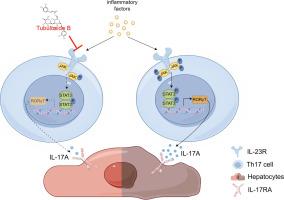Tubuloside B alleviates con A-induced acute liver injury by inhibiting the IL-23/JAK2/STAT3 signaling pathway hyperactivation during Th17 cell differentiation
IF 4.7
2区 医学
Q2 IMMUNOLOGY
引用次数: 0
Abstract
Background
Tubuloside B (TB), a phenylethanoid glycoside from Cistanche salsa, has been reported to exhibit anti-inflammatory and anti-HCC properties; however, its therapeutic efficacy and underlying mechanisms in concanavalin A (Con A)-induced liver injury remain unclear.
Methods
We employed a Con A-induced acute liver injury (ALI) mouse model and in vitro Th17 differentiation assays were employed to investigate the therapeutic potential and mechanisms of TB through serum biochemistry, histopathology, flow cytometry, RNA sequencing, qPCR, and Western blotting (WB).
Results
TB significantly reduced Con A-induced elevations in serum ALT/AST levels, ameliorated hepatic necrosis and inflammatory infiltration, and suppressed pro-inflammatory cytokines in vivo. RNA-seq and pathway analysis revealed that TB inhibited the IL-17A signaling pathway and restored the Th17/Treg balance by reducing Th17 cell proportions (CD4+IL-17A+ and CD4+RORγt+) while increasing Treg proportions (CD25+Foxp3+). Mechanistically, TB inhibited IL-17A-driven activation of NF-κB and MAPK pathways in the liver. Furthermore, molecular docking and in vitro Th17 differentiation assays demonstrated that TB directly targeted IL-23R (ΔG = −10.9 kcal/mol), suppressed IL-23-induced overactivation of the JAK2/STAT3 pathway (p-JAK2, p-STAT3), and inhibited pathogenic Th17 differentiation.
Conclusions
Collectively, our findings demonstrate that TB alleviates Con A-induced ALI by blocking the IL-23/JAK2/STAT3 signaling axis during Th17 cell differentiation, thereby attenuating IL-17-mediated hepatic inflammation. This study highlights TB as a potential natural therapeutic candidate for ALI and suggests its potential application in mitigating autoimmune hepatitis (AIH) progression.

Tubuloside B通过抑制Th17细胞分化过程中IL-23/JAK2/STAT3信号通路的过度激活,减轻con - a诱导的急性肝损伤
tubuloside B (TB)是一种来自肉苁蓉的苯乙醇苷,据报道具有抗炎和抗hcc的特性;然而,其治疗刀豆蛋白A (Con A)诱导的肝损伤的疗效和潜在机制尚不清楚。方法采用Con - a诱导的急性肝损伤(ALI)小鼠模型,通过血清生化、组织病理学、流式细胞术、RNA测序、qPCR、Western blotting (WB)等方法研究Th17体外分化对TB的治疗作用及其机制。结果stb显著降低Con - a诱导的血清ALT/AST水平升高,改善肝坏死和炎症浸润,抑制体内促炎因子。RNA-seq和通路分析显示,TB抑制IL-17A信号通路,通过降低Th17细胞比例(CD4+IL-17A+和CD4+RORγt+),增加Treg比例(CD25+Foxp3+),恢复Th17/Treg平衡。在机制上,TB抑制il - 17a驱动的肝脏NF-κB和MAPK通路的激活。此外,分子对接和体外Th17分化实验表明,TB直接靶向IL-23R (ΔG =−10.9 kcal/mol),抑制il -23诱导的JAK2/STAT3通路的过度激活(p-JAK2, p-STAT3),抑制致病性Th17分化。总之,我们的研究结果表明,结核通过阻断Th17细胞分化过程中的IL-23/JAK2/STAT3信号轴,从而减轻了Con - a诱导的ALI,从而减轻了il -17介导的肝脏炎症。这项研究强调了结核病作为ALI的潜在天然治疗候选者,并提示其在减轻自身免疫性肝炎(AIH)进展方面的潜在应用。
本文章由计算机程序翻译,如有差异,请以英文原文为准。
求助全文
约1分钟内获得全文
求助全文
来源期刊
CiteScore
8.40
自引率
3.60%
发文量
935
审稿时长
53 days
期刊介绍:
International Immunopharmacology is the primary vehicle for the publication of original research papers pertinent to the overlapping areas of immunology, pharmacology, cytokine biology, immunotherapy, immunopathology and immunotoxicology. Review articles that encompass these subjects are also welcome.
The subject material appropriate for submission includes:
• Clinical studies employing immunotherapy of any type including the use of: bacterial and chemical agents; thymic hormones, interferon, lymphokines, etc., in transplantation and diseases such as cancer, immunodeficiency, chronic infection and allergic, inflammatory or autoimmune disorders.
• Studies on the mechanisms of action of these agents for specific parameters of immune competence as well as the overall clinical state.
• Pre-clinical animal studies and in vitro studies on mechanisms of action with immunopotentiators, immunomodulators, immunoadjuvants and other pharmacological agents active on cells participating in immune or allergic responses.
• Pharmacological compounds, microbial products and toxicological agents that affect the lymphoid system, and their mechanisms of action.
• Agents that activate genes or modify transcription and translation within the immune response.
• Substances activated, generated, or released through immunologic or related pathways that are pharmacologically active.
• Production, function and regulation of cytokines and their receptors.
• Classical pharmacological studies on the effects of chemokines and bioactive factors released during immunological reactions.

 求助内容:
求助内容: 应助结果提醒方式:
应助结果提醒方式:


